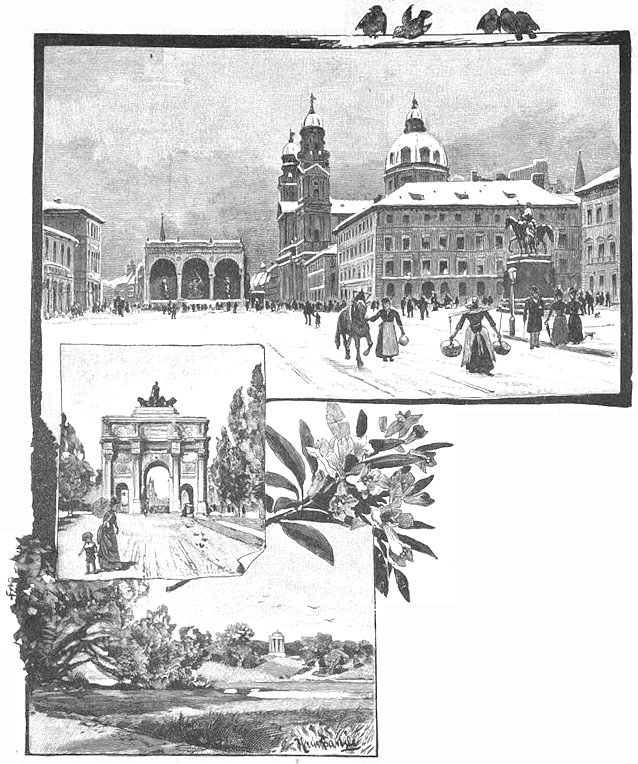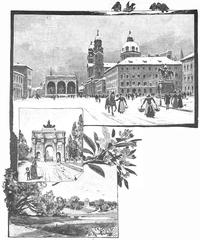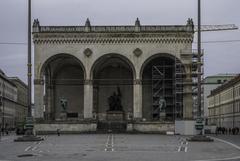
Platz vor der Feldherrnhalle: Visiting Hours, Tickets, and Historical Insights
Date: 17/07/2024
Introduction
Platz vor der Feldherrnhalle, located in the heart of Munich, Germany, is a historical site with deep cultural significance. This iconic square, featuring the monumental loggia known as the Feldherrnhalle, is a tribute to Bavarian military history and a poignant reminder of pivotal moments in 20th-century European history. Constructed between 1841 and 1844 by Friedrich von Gärtner upon the commission of King Ludwig I of Bavaria, the Feldherrnhalle was inspired by the Loggia dei Lanzi in Florence, Italy. It commemorates the military leaders of Bavaria, showcasing statues of notable figures such as Johann Tilly and Karl Philipp von Wrede (Munich Tourist Information). The square has witnessed significant historical events, including the Beer Hall Putsch of 1923, which marked a pivotal moment in the rise of the Nazi Party (History.com). Additionally, it holds a connection to the White Rose movement, a non-violent resistance group that opposed the Nazi regime (Munich Memorials). Today, the Platz vor der Feldherrnhalle remains a vibrant public space and a popular starting point for walking tours of Munich, offering visitors a glimpse into the city’s rich historical tapestry. This guide will provide a comprehensive overview of the site’s history, architectural beauty, and practical visitor information to help you make the most of your visit.
Table of Contents
- Introduction
- History of Platz vor der Feldherrnhalle
- Visitor Information
- Conclusion
- FAQ
- What are the visiting hours for Platz vor der Feldherrnhalle?
- Is there an entrance fee for Platz vor der Feldherrnhalle?
- How can I get to Platz vor der Feldherrnhalle?
- Are there guided tours available for Platz vor der Feldherrnhalle?
- What are some nearby attractions to Platz vor der Feldherrnhalle?
- Call to Action
History of Platz vor der Feldherrnhalle
Origins and Early History
Platz vor der Feldherrnhalle, located in the heart of Munich, Germany, is a site steeped in historical significance. The square is named after the Feldherrnhalle, a monumental loggia built between 1841 and 1844 by Friedrich von Gärtner. Commissioned by King Ludwig I of Bavaria, the structure was inspired by the Loggia dei Lanzi in Florence, Italy. The Feldherrnhalle was intended to honor the Bavarian Army and commemorate the military leaders of Bavaria.
Architectural Significance
The Feldherrnhalle is an architectural marvel, showcasing the grandeur of 19th-century neoclassical design. The structure features three large arches and is adorned with statues of notable military figures, including Johann Tilly and Karl Philipp von Wrede. The central arch houses a bronze statue of the Bavarian Army, symbolizing the military prowess and heritage of Bavaria. The design and construction of the Feldherrnhalle were part of King Ludwig I’s broader vision to transform Munich into a “German Athens,” a city that would rival the cultural and architectural splendor of ancient Athens.
The Beer Hall Putsch
One of the most significant events in the history of Platz vor der Feldherrnhalle is the Beer Hall Putsch of 1923. On November 9, 1923, Adolf Hitler and his followers attempted to overthrow the Weimar Republic by marching from the Bürgerbräukeller beer hall to the Feldherrnhalle. The coup was quickly suppressed by the Bavarian police, resulting in the deaths of 16 Nazi supporters and four police officers. This failed coup marked a pivotal moment in German history, as it led to Hitler’s imprisonment and the subsequent rise of the Nazi Party. Today, a plaque at the site commemorates the police officers who lost their lives during the putsch.
World War II and Post-War Period
During World War II, Platz vor der Feldherrnhalle and the surrounding area suffered significant damage from Allied bombings. The Feldherrnhalle itself was partially destroyed but was later restored to its former glory. In the post-war period, the square became a symbol of Munich’s resilience and recovery. The restoration efforts were part of a broader initiative to preserve Munich’s historical and cultural heritage, ensuring that future generations could appreciate the city’s rich history.
The White Rose Movement
Platz vor der Feldherrnhalle also holds a poignant connection to the White Rose movement, a non-violent resistance group that opposed the Nazi regime. In 1943, members of the White Rose, including Hans and Sophie Scholl, were executed for distributing anti-Nazi leaflets. The movement’s legacy is commemorated near the square, serving as a reminder of the courage and sacrifice of those who stood against tyranny.
Modern-Day Significance
Today, Platz vor der Feldherrnhalle is not only a historical landmark but also a vibrant public space that attracts tourists and locals alike. The square is a popular starting point for walking tours of Munich, offering visitors a glimpse into the city’s storied past. The Feldherrnhalle remains a symbol of Bavarian pride and resilience, standing as a testament to the city’s ability to endure and overcome adversity.
Visitor Information
Visiting Hours and Ticket Prices
Platz vor der Feldherrnhalle is open to the public 24 hours a day, seven days a week. There is no entrance fee for visiting the square or the Feldherrnhalle itself. However, guided tours that include the square and other historical sites in Munich may have associated costs.
Travel Tips and Accessibility
For those planning to visit Platz vor der Feldherrnhalle, it is advisable to allocate sufficient time to explore the square and its surroundings. The site is easily accessible by public transportation, with several tram and bus lines stopping nearby. Visitors can also enjoy a leisurely stroll through the adjacent Odeonsplatz, which features other notable landmarks such as the Theatinerkirche and the Residenz.
To fully appreciate the historical context of Platz vor der Feldherrnhalle, consider joining a guided tour. Many local tour operators offer in-depth tours that cover the square’s history, architecture, and significance. Additionally, the nearby Munich Documentation Centre for the History of National Socialism provides valuable insights into the events of the Beer Hall Putsch and the rise of the Nazi Party.
Nearby Attractions
While visiting Platz vor der Feldherrnhalle, take the time to explore nearby attractions such as the Theatinerkirche, a stunning Baroque church, and the Residenz, the former royal palace of the Bavarian monarchs. Both sites offer additional historical and architectural insights into Munich’s rich heritage.
Conclusion
Platz vor der Feldherrnhalle stands as a testament to Munich’s rich historical and cultural heritage. From its neoclassical architecture to its role in pivotal historical events such as the Beer Hall Putsch, the square offers a profound insight into the city’s past and its resilience through times of adversity. Today, it remains a vibrant public space that continues to attract tourists and locals alike, serving as both a place of remembrance and a symbol of Bavarian pride. Whether you are a history enthusiast or a casual visitor, exploring Platz vor der Feldherrnhalle provides a unique opportunity to connect with Munich’s storied past. Be sure to take advantage of the guided tours available to fully appreciate the site’s historical context and significance. For those planning a visit, the square is open 24/7 and easily accessible by public transportation, with nearby attractions such as the Theatinerkirche and the Residenz offering additional historical and architectural insights (Munich City Guide). By visiting Platz vor der Feldherrnhalle, you not only witness a piece of Munich’s history but also contribute to the ongoing preservation and appreciation of its cultural legacy.
FAQ
Q - What are the visiting hours for Platz vor der Feldherrnhalle?
A - Platz vor der Feldherrnhalle is open to the public 24 hours a day, seven days a week.
Q - Is there an entrance fee for Platz vor der Feldherrnhalle?
A - No, there is no entrance fee for visiting the square or the Feldherrnhalle itself.
Q - How can I get to Platz vor der Feldherrnhalle?
A - The site is easily accessible by public transportation, with several tram and bus lines stopping nearby.
Q - Are there guided tours available for Platz vor der Feldherrnhalle?
A - Yes, many local tour operators offer in-depth tours that cover the square’s history, architecture, and significance.
Q - What are some nearby attractions to Platz vor der Feldherrnhalle?
A - Nearby attractions include the Theatinerkirche and the Residenz, both of which offer additional historical and architectural insights into Munich’s rich heritage.
Call to Action
For more information on historical sites in Munich, download our mobile app Audiala, check out our related posts, or follow us on social media for the latest updates and travel tips.






































































































